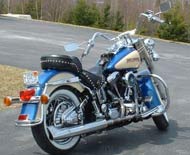8/20/2007
Appeals Court Authorizes Lethal Force in Low Speed ChasesUS Appeals Court rules that police may use lethal force against a motorist who scares other motorists to death in a low-speed chase.

A federal court last month gave police the green light to use deadly force to end low-speed chases that follow from minor traffic infractions. In a 3-0 decision, the Fourth Circuit US Court of Appeals expanded upon the conclusions reached in a US Supreme Court decision from May that authorized police to use lethal force to end any pursuit considered "dangerous" (view decision).
On August 3, 2001, Deputy Sheriff Rodney Coe claimed that motorcyclist Gerald "Tiny" Abney, 40, had crossed double-yellow lines while passing on a curve on Old Country Farm Road near Asheboro, North Carolina. Abney ignored Coe's signal to pull over and instead attempted to lose the deputy on the twisty mountain road. According to witnesses, when Coe eventually caught up he used his patrol car to push Abney's 1987 Harley Davidson into a ditch. Abney maintained control and drove back onto the road to continue his flight. At no time during the eight-mile daytime pursuit did Abney or Coe exceed the road's 55 MPH speed limit.
After turning onto Mount Shepherd Road, however, Coe rammed the motorcycle a second time, knocking Abney off his bike and killing him. Abney's family filed a lawsuit claiming Coe used unreasonable force. In its July decision, the federal appeals court rejected the family's argument by asserting the low-speed chase was, in fact, dangerous.
"The record is replete with examples of reckless driving designed to elude the police and executed with little consideration for the lives and safety of other motorists," the opinion of the three-judge panel stated. "Diane Davis, who drove the front vehicle in a line of three or four vehicles passed by Abney, testified that she was 'literally scared to death.'"
In its decision, the appeals court dismissed the relevance of the low speeds involved and the substantially increased risk of killing a motorcyclist by ramming him with a police cruiser.
"The fact that Abney was driving during the day... means only that Abney had the opportunity to scare more motorists to death," the court wrote. "Because we hold Deputy Coe's conduct was reasonable, plaintiff cannot prevail."
The Abney family strongly disagreed in a statement issued days after the incident.
"No one deserves to be killed over a traffic violation," the family press release stated. "Tiny may have been observed passing on a double yellow, but that hardly justifies being run over by a two-ton squad car... His death by an apparently ill-trained, over zealous cop should never have happened."
Family members also accused police of downplaying in official reports the evidence they believe showed that Coe intentionally struck Abney.
"The shirt [Tiny] was wearing has tire marks on the back," the family stated. "The rear of the patrol car came to rest on top of Tiny's bike. The accident report says Deputy Coe hit Tiny causing him to go down. These are the relevant facts, not what some police department which is itself in violation of the law claims they discovered after the fact."
The full text of the decision is available in a 72k PDF file at the source link below.


